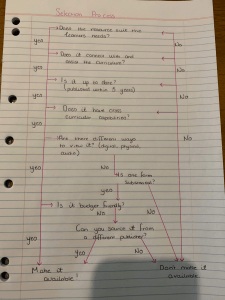The role and nature of school library collections.
When thinking about the physical space of the library, its role has evolved over the years to suit the needs of the learning community, however, the core feature has stayed the same. A learning space where reading, inquiry, research, thinking, imagination, and creativity is central to students’ information to knowledge journey and to help develop their social, personal and cultural growth (IFLA School Library Guidelines, 2015, p. 16). Though, the smooth running of the library space would not happen if it weren’t for the Teacher Librarian to oversee it all. The teacher librarian to a library is like Mjolnir is to Thor or The Eye of Agamotto is to Doctor Strange. They both hold the power to change the present and the future for the best. Wielding such powers is no easy feat, Teacher librarians must be able to distinguish between the important and the insignificant all while trying to maintain a relevant collection and learning environment and defend any potential issues (enemies) that may come about. Collection development policies could be seen as their sidekick to help relieve some of the stress of running a library.
While still being the brains of the operation, teacher librarians can turn to the collection development policy to give them some assistance along the way on how to defend their collection, or universe. The teacher librarian must make informed decisions based on the school community and the long-term goals and priorities that are set out in the collection development policy (Johnson, 2014, p. 138). A simple selection process can be created to help with quick fire decisions in a standard yes or no format (Boeti, 2019, March 28). In doing so, the teacher librarian can keep a mental log of this process, as it is not too detailed, and quickly assess a resource to see if it is worthy to move on to the detailed selection process.
Importance of a collection development policy
Much like sidekicks, collection development policies are there to support the hero of the library, the teacher librarian. By having this document in place, it outlines how the collection will be created and how it will meet the needs of its community (Braxton, 2014). It will also assist in how to acquire the resources and what the process is in regard to deselection. There are schools, however, that do not have a documented version of the policy and follow with the mentality that we do what we have always done and there is no need to write it down (Boeti, 2019, May 27). This can come at a cost to the library as the policy is there in case the teacher librarian is not available or decides to move schools. Without their sidekick, the hero is at a loss and the same goes for teacher librarians. A library cannot run effectively if there is not a collection development policy in place.
Future proofing the collection
By constantly analyzing the collection and deselecting the outdated or irrelevant materials, teacher librarians can maintain the best collection they can (Boeti, 2019, May 27). There also needs to be a collaboration between the teacher librarian and administration to ensure that the library will run smoothly. If there is that connection in place, the promotion of resources and activities run by the library will occur naturally and there will be a vested interest in the space from the school community because they will see that there is support for the library. There may be an increase in challenged materials in the future so policies should adapt accordingly. Self-censorship should not be put in place, a resource should not be restricted from purchase based on the teacher librarian deeming it inappropriate for readers (Jacobson, 2016, p. 21). By having a collection development policy in place, there is little room for error and questioning by administration. As well a sidekick, the collection development policy is a shield of protection for the teacher librarian.
Part B References:
Boeti, A. (2019, May 27). Collection Analysis [Online discussion post]. Retrieved from Charles Sturt University website: https://interact2.csu.edu.au/webapps/discussionboard/do/message?action=list_messages&course_id=_42383_1&nav=discussion_board_entry&conf_id=_78886_1&forum_id=_147540_1&message_id=_2311447_1
Boeti, A. (2019, May 27). Digital content within a collection development policy [Online Discussion comment]. Retrieved from Charles Sturt University website: https://interact2.csu.edu.au/webapps/discussionboard/do/message?action=list_messages&course_id=_42383_1&nav=discussion_board_entry&conf_id=_78886_1&forum_id=_147542_1&message_id=_2294288_1
Boeti, A. (2019, March 28). Selection process [Thinkspace blog]. Retrieved from Charles Sturt University website: https://thinkspace.csu.edu.au/adeleboeti/2019/03/28/5/
Braxton, B. (2014). Sample collection policy. Retrieved from http://500hats.edublogs.org/policies/sample-collection-policy/
International federation of Library Associations and Institutions/United Nations Educational Scientific and Cultural Organisation. (2015). School Library Guidelines. Retrieved from https://www.ifla.org/files/assets/school-libraries-resource-centers/publications/ifla-school-library-guidelines.pdf
Jacobson, L. (2016). Unintentional selection: restricting books with controversial content is on the rise in school libraries. School Library Journal, 62(10), 20-24. Retrieved from http://web.a.ebscohost.com.ezproxy.csu.edu.au/ehost/pdfviewer/pdfviewer?vid=1&sid=76df5959-93b8-4b6f-b81e-bb5b57f2df39%40sdc-v-sessmgr06

